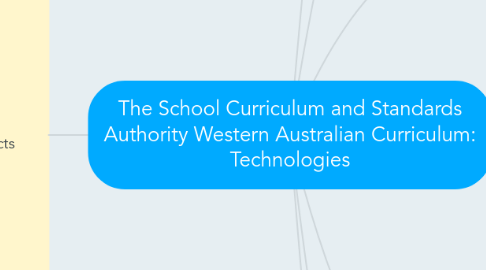
1. Content Structure/Subjects
1.1. Design and Technologies
1.1.1. Strands
1.1.1.1. Knowledge and Understanding
1.1.1.1.1. Technologies and Society
1.1.1.1.2. Technologies Contexts
1.1.1.2. Processes and Production Skills
1.1.1.2.1. Developing skills based on design thinking, design processes and production processes through 5 process and production skills.
1.2. Digital Technologies
1.2.1. Strands
1.2.1.1. Knowledge and Understanding
1.2.1.1.1. Digital Systems
1.2.1.1.2. Representation of Data
1.2.1.2. Processes & Production SKills
1.2.1.2.1. Providing opportunities to problem-solve using appropriate technologies for technological solutions, including; - Collecting, managing and analysing data - Digital implementation - Creating solutions by investigating and defining, designing, producing and implementing, evaluating and collaborating & managing.
1.2.2. Year Level
1.2.2.1. Foundation
1.2.2.2. Year 3 - Year 4
1.2.2.3. Year 5 - Year 6
1.2.2.4. Year 7 - Year 8
1.2.2.5. Year 9 - Year 10
1.3. Content descriptions and elaborations
1.3.1. Scope and Sequence
1.4. Assessment
1.4.1. The two strands; knowledge & understanding and processes & production skills are assessed on in Design & Technology and Digital Technologies. by providing students with opportunities to demonstrate their knowledge, understanding and skills. The assessment strategies may include; - Observations - Group activities - Video and audio recordings - Fieldwork and practical 'authentic' evidence - Portfolios and work samples - Tests and quizzes - Written work - Graphic organisers - Visual representations - Performances or oral presentations - Conferences - Self assessment, evaluations and student journals - Peer assessment
1.5. Achievement Standards
1.5.1. From Pre-primary to Year 10, achievement standards indicate the quality of learning including depth of conceptual understanding and sophistication of skills that would indicate for all students to be at the Year level by the end of the year to commence the learning required for the next year level of achievement.
2. Year Levels
2.1. Pre-primary
2.1.1. Content Description
2.1.2. Achievement Standards
2.2. Year 1
2.2.1. Content Decription
2.2.2. Achievement Standard
2.3. Year 2
2.3.1. Content Description
2.3.2. Achievement Standard
2.4. Year 3
2.5. Year 4
2.6. Year 5
2.7. Year 6
2.8. Year 7
2.9. Year 8
2.10. Year 9
2.11. Year 10
3. Curriculum Aims & Objectives
3.1. Confidently use and create technology in a variety of formats (traditional, 21st century and future technologies) and develop understanding of the progress of technology over time.
3.2. Select, use and develop appropriate technologies for intended outcomes.
3.3. Use technologies appropriately and ethically for sustainability with environment and economy.
3.4. Provide opportunities for students to use problem-solving skills for technology solutions.
3.5. Develop students knowledge, understanding and skills in technology.
4. Student Diversity
4.1. SCASA provides a Western Australian Curriculum that is accessible for all students.
4.1.1. Students with disability
4.1.2. Gifted and talented students
4.1.3. English as an additional language or dialect
